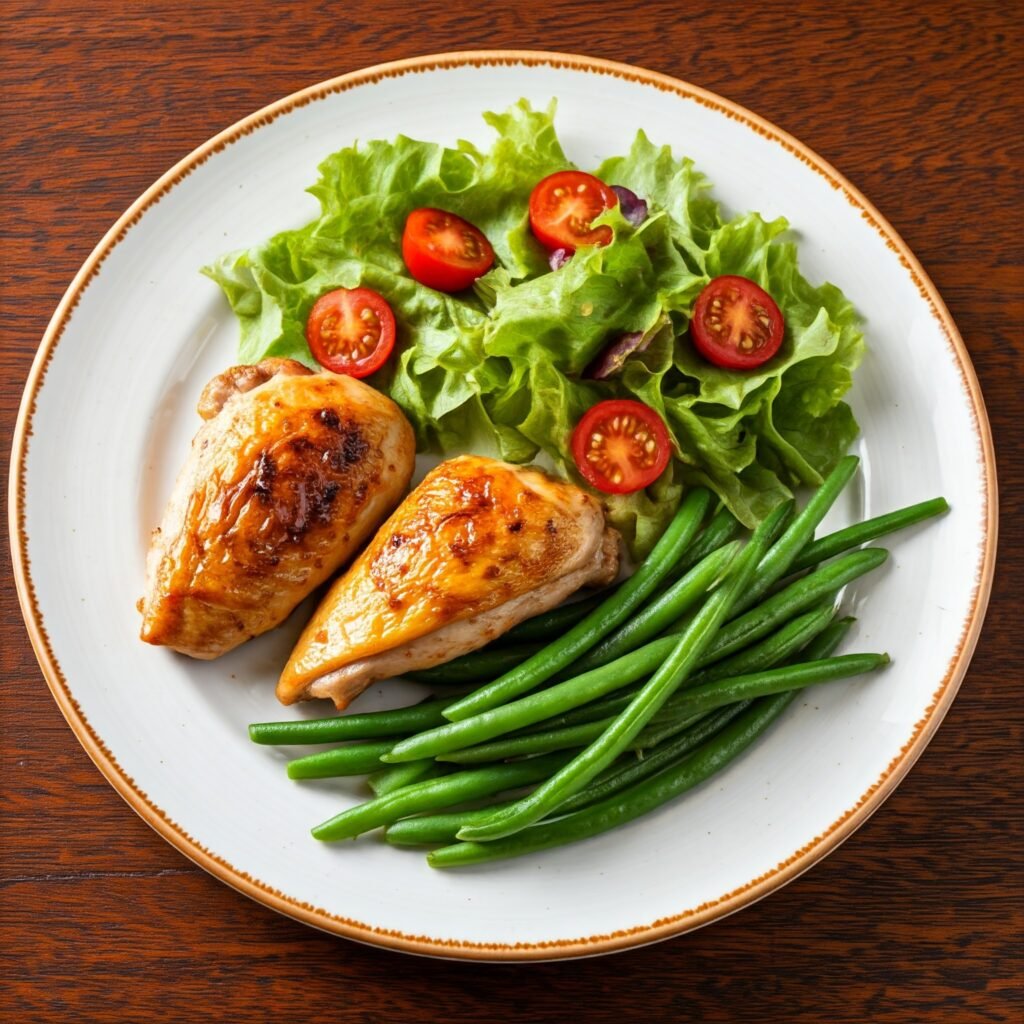Roasted Chicken & Green Beans, My Go-To Healthy Dinner Combo
Because it is low in fat and a decent source of protein when compared to other cooking methods, rotisserie chicken can be a healthy choice. But, it’s vital to keep in mind that some store-bought rotisserie chickens may have a high sodium level. It can also be healthier to remove the chicken’s skin because it can contain a lot of fat. All things evaluated, when rotisserie chicken is eaten in moderation and with consideration for portion sizes and additional ingredients, it can be as part of a balanced diet.
Since rotisserie chicken is baked rather than fried in oil, many people believe it to be healthier than fried or boiling chicken.

Nevertheless, what’s smeared on the chicken as it cooks determines its health advantages.
A rotisserie chicken from one grocery shop, for instance, might not have the same nutritional value as one from a different grocery store or restaurant.
“People should not assume that [rotisserie] is automatically healthy,” stated Stanford Children’s Health Center in California’s director of Nutrition and Weight Management, Dr. Andrea Garber, M.D., M.P.H.
Garber continued, “There are so many varieties of rotisserie chickens available, many of them loaded with calories and fat that sometimes they can even be worse for you than fried chicken.” According to her, the healthier options available at most shops have between 480 and 640 calories and 16 to 20 grams of fat per chicken.

Some well-known, oily, or hot types may have up to 1,000 calories. For example, one serving size of Chick-fil-A’s rotisserie chicken contains around 750 calories. While there are undoubtedly healthier rotisserie chickens available, if you’re trying to follow a diet, you need to carefully review the nutrition details.
Rotisserie or roasted entire chickens would be fine to consume on a regular basis if you make your own at home. However, the ones made at the grocery stores have a lot of salt added to them (the skin and cavity may have been brined and then salted further). Regular consumption of these will undoubtedly cause your salt intake to surpass the daily recommended limit.

Roasted chicken is quite simple to make at home. Remove the uncooked chicken from its container. Utilizing paper towels, dry it off. Inside the bird, sprinkle a seasoning combination of your favorite dried herbs and spices (don’t forget to add lots of garlic and paprika) and rub it over the skin with some olive oil or neutral cooking oil. Cut a large onion in half and stuff the pieces, along with some carrot slices and two orange or lemon slices, within its center.
Once the fluids run clear when you cut through the thigh bone, roast the chicken in an oven at 375 degrees Fahrenheit for about 20 minutes per pound of chicken.

From a nutritional perspective, though, they’re all essentially the same. All that’s left to watch over is the amount of extra water and salt that’s injected into the bird, as well as any other substances that may be present in the brine (such as sugars). These increase sodium and calorie content while decreasing the amount of protein you receive per ounce.
Rotisserie chicken is generally a healthy option. It’s a cheap, easy substitute for less healthful fast-food options, and it’s high in protein and nutrients. Since rotisserie chicken is packed with essential minerals and high-quality protein, it is not inherently problematic. However, the sodium content of the chicken can vary greatly depending on how it is seasoned.
Yet it is quite nutritive. There’s lots of healthy fats and protein in there, all of which is seasoned to absolute perfection.

For a Well-Balanced Dinner, Serve alongside Some Sautéed Green Beans & Possibly Some Mashed Potatoes,
Apart from to being reasonably priced, green beans are high in beta-carotene, an antioxidant that gives fruits and vegetables their color, and vitamins C and A. besides to being a strong source of potassium, which lowers blood pressure, and folate (one cup of raw green beans provides 33 micrograms, or nearly 10% of the daily necessary amount), the vegetable also helps fight inflammation. Also, green beans are high in fiber and protein, both of which reduce cholesterol. Consuming them could be good for your heart and other parts of your body. Together with to these vitamins & minerals, a cup of raw green beans contains:

- Vitamin B-6: 0.14 mg
- Vitamin E: 0.41 mg
- Vitamin K: 43 mcg
- Thiamin: 0.1 mg
- Niacin: 0.7 mg
- 1.03 mg of iron
- 37 mg of calcium
- Phosphorus: 38 mg
- 25 mg of magnesium
- Zinc: 0.24 mg
- Potassium: 211 mg
You Can Eat Raw Green Beans to Fill You Up, or Try Something Like This,
- Sauté fresh green beans with olive oil, garlic, salt, pepper and lemon juice.
- Combine blanched or steamed green beans with a green salad.
- Toss green beans with olive oil, pepper, and Parmesan cheese. Roast at 425°F (218°C) until crisp-tender.
- Toss freshly blanched or steamed green beans with cherry tomatoes and balsamic vinegar.

This is the reason I enjoy having such a perfect combination for dinner with my family on a frequent basis. You should give this a try as well; I’m confident you’ll love it and that this combo will become your preferred option for a healthy eating plan.







